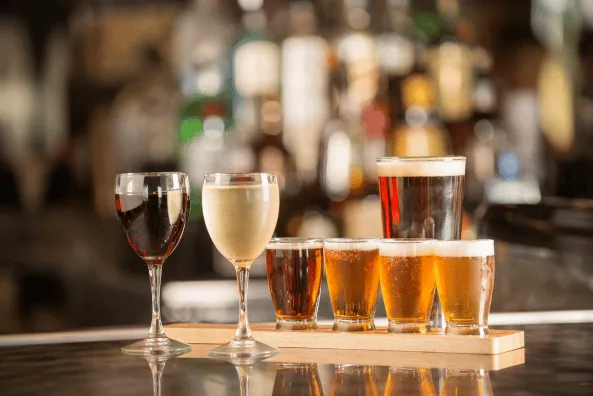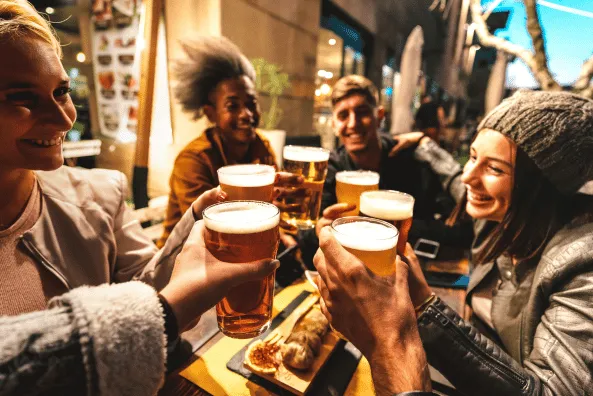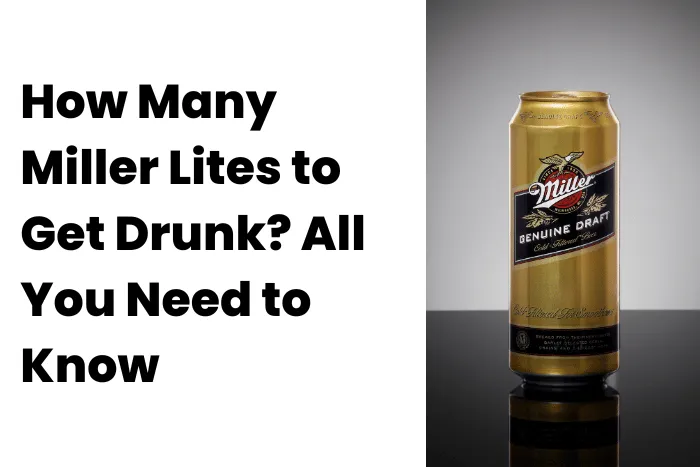Do you want to know how many Miller Lites it takes for an average person to get drunk? Answering this query is complicated, as many variables must be considered. Weight, height, sex, and age all play a role in determining just how much alcohol is needed before someone reaches their tipping point. In this blog post, we’ll explore the Alcohol Content of Miller Lite versus other beer brands and discuss tips on responsible drinking so you don’t become too intoxicated after having one (or more) too many Miller Lites.
Table of Contents:
- How Many Miller Lites Does it Take to Get Drunk?
- Factors That Determine How Quickly You Will Get Drunk
- The Effects of Alcohol on the Body
- Tips for Responsible Drinking
- FAQs in Relation to How Many Miller Lites to Get Drunk
- Conclusion
How Many Miller Lites Does it Take to Get Drunk?
The quantity of Miller Lite needed to become inebriated can vary depending on several elements, such as body mass index, stature, gender, and age. The rate of alcohol absorption depends on body size and type. Physiologically, women intoxicate faster than males. Younger folks can drink more before becoming intoxicated.
Miller Lite has an alcohol content of 4.2% by volume (ABV). That means that for every 12-ounce can or bottle of Miller Lite consumed, you consume approximately 0.5 ounces of pure ethanol alcohol—the intoxicating ingredient in beer and other alcoholic beverages. To put this into perspective, most cocktails contain 1–1 ½ ounces of liquor per serving, which equates to 8–12% ABV depending on the brand used when mixed with mixers like soda or juice.
That said, it should take a 180-pound adult male four 12-ounce cans of Miller Lite to reach the 0.08% BAC level, which is considered legally intoxicated in many jurisdictions.
For those looking for a lower ABV option, there are many alternatives available, including light beers like Coors Light (4%), Bud Light (4%), and Michelob Ultra (4%).
Non-alcoholic beers have zero percent ABV, so they won’t make you drunk but still offer some flavor options similar to their alcoholic counterparts without any intoxication risk.
Since alcohol affects individuals differently, the amount of Miller Lite needed for someone to become inebriated can vary. Considering the individual differences in alcohol tolerance, let us explore what may impact one’s level of intoxication when consuming beer.
Factors That Determine How Quickly You Will Get Drunk

Alcohol consumption affects individuals differently, depending on a variety of factors. Weight and body mass index (BMI) are two significant contributors to how quickly someone will become intoxicated after drinking beer. Generally, the higher one’s BMI is, the more alcohol they need to consume to become intoxicated. Due to weaker alcohol dehydrogenase levels, women get drunk faster than males. Young adults may get drunk faster than beer-drinking adults. Finally, eating before drinking slows absorption into the bloodstream, reducing drunkenness over time.
To sum up, several factors determine how quickly someone will get drunk when they drink beer: weight/BMI, gender differences in alcohol metabolism, age and tolerance level for alcohol, and amount of food consumed beforehand or during consumption. Knowing these variables can help drinkers make informed decisions about their limits so they don’t become overly intoxicated at their next social gathering.
The Effects of Alcohol on the Body
Consuming alcohol can have immediate and lasting impacts on the body, so it is essential to be aware of these effects when making decisions about drinking. It is crucial to understand how alcohol affects your body so that you can make informed decisions about drinking responsibly.
Short-Term Effects of Alcohol Consumption:
When consumed in moderation, alcohol can cause mild relaxation and euphoria. Excessive alcohol intake can reduce cognitive abilities, coordination issues, slurred speech, nausea, and vomiting; extreme cases may lead to blackouts or coma. In extreme cases, it can even lead to blackouts or coma due to alcohol poisoning.
Consuming five drinks within two hours can rapidly impair judgment and motor skills, increasing the risk of injury from accidents or violence. Additionally, binge drinkers are more likely to suffer from hangovers the next day, which can be debilitating depending on the amount consumed; these hangovers often include headaches, nausea, fatigue, dehydration, dizziness, light sensitivity, poor concentration, and irritability.
If any of these tell-tale signs manifest after drinking, it is advisable to seek medical attention to nip the problem in the bud before matters worsen.
Long-Term Effects of Alcohol Consumption:
Prolonged drinking can lead to alcohol dependence, changing brain chemistry, and potentially addiction or alcoholism if left unaddressed. Chronic drinkers are also at an increased risk for developing certain types of cancers, including mouth cancer, throat cancer, and breast cancer, among others. Additionally, long-term alcohol use can result in cognitive deficits and sexual dysfunction due to nerve harm brought on by continued exposure to ethanol.
In conclusion, understanding how your body responds to different levels of alcoholic beverages is an essential part of responsible decision-making regarding using them to enjoy without negative consequences health-wise safely.
Tips for Responsible Drinking

Before imbibing, determine a personal limit to ensure responsible drinking and alternate between alcoholic and non-alcoholic beverages. Knowing how much alcohol you can handle and not exceeding it will assist in preventing alcohol-related problems. It’s also important to alternate between alcoholic drinks and non-alcoholic beverages such as water or soda throughout the night. Since food absorbs alcohol in your stomach, eating before or while drinking beer slows absorption. Finally, know your limit and stop drinking when you do, no matter how tempting. Despite social pressure, don’t go over your limit. As they say: “Everything in moderation.”
FAQs in Relation to How Many Miller Lites to Get Drunk
How many cans of Miller Lite does it take to get drunk?
Since the amount of alcohol needed to become intoxicated varies by person, this question cannot be answered. Body weight, gender, metabolism rate, and tolerance determine how soon Miller Lite or other alcoholic beverages affect a person. Four 12-ounce Miller Lite cans would give a 180-pound guy 0.08% BAC, the legal limit in many places.
How many beers does it take to feel drunk?
The amount of brews required to experience intoxication fluctuates depending on the person’s stature, weight, gender, and capacity for alcohol. Generally speaking, most people will start feeling some effects after consuming two or three beers in an hour. However, this can vary significantly depending on each person’s body chemistry and alcohol sensitivity. It is important to note that even if someone does not feel “drunk” after drinking several beers, they may still be legally intoxicated and should avoid driving or engaging in other activities requiring alertness and coordination.
Can three beers get you drunk?
It may be achievable for three brews to induce intoxication, contingent upon multiple aspects. Three drinks can intoxicate someone depending on the beer’s potency, body size, and weight. Moreover, the beer consumption rate can also influence if you become inebriated. Ultimately, it’s best to consume alcoholic beverages responsibly and never exceed your drinking limits.
How many Miller High Lifes does it take to get drunk?
The number of Miller High Lifes needed to get intoxicated depends on weight, gender, metabolism, and other factors. Generally, it would take a normal-sized adult male four 12oz containers or bottles of Miller High Life to become inebriated. For females and more petite individuals, fewer drinks may be necessary. As with any alcoholic beverage, consumption should always be done responsibly and in moderation.
Conclusion
It is essential to understand that drinking too many Miller Lites or any other alcoholic beverage can have serious consequences. Responsible drinking is essential to avoid the adverse effects of excessive alcohol consumption, which varies by weight, height, and sex. Realizing the amount one can consume without becoming intoxicated is essential for preventing the detrimental consequences of overindulging in alcohol. Remember: Always practice responsible drinking habits when consuming Miller Lite or any other beer.
Discover the best beers to get you drunk with our comprehensive reviews and beer subscription services. Make your craft brews at home using our selection of top-notch brewing equipment!
Also Visit: Unlock the Differences: Amber Ale vs Pale Ale

